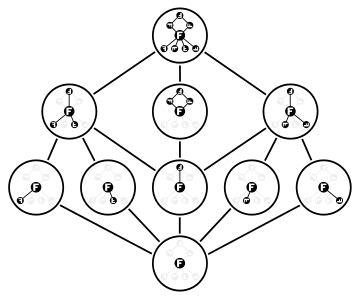
In mathematics, particularly in group theory, the Frattini subgroup of a group G is the intersection of all maximal subgroups of G. For the case that G has no maximal subgroups, for example the trivial group {e} or a Prüfer group, it is defined by . It is analogous to the Jacobson radical in the theory of rings, and intuitively can be thought of as the subgroup of "small elements" (see the "non-generator" characterization below). It is named after Giovanni Frattini, who defined the concept in a paper published in 1885.
Some facts
- is equal to the set of all non-generators or non-generating elements of G. A non-generating element of G is an element that can always be removed from a generating set; that is, an element a of G such that whenever X is a generating set of G containing a, is also a generating set of G.
- is always a characteristic subgroup of G; in particular, it is always a normal subgroup of G.
- If G is finite, then is nilpotent.
- If G is a finite p-group, then . Thus the Frattini subgroup is the smallest (with respect to inclusion) normal subgroup N such that the quotient group is an elementary abelian group, i.e., isomorphic to a direct sum of cyclic groups of order p. Moreover, if the quotient group (also called the Frattini quotient of G) has order , then k is the smallest number of generators for G (that is, the smallest cardinality of a generating set for G). In particular a finite p-group is cyclic if and only if its Frattini quotient is cyclic (of order p). A finite p-group is elementary abelian if and only if its Frattini subgroup is the trivial group, .
- If H and K are finite, then .
An example of a group with nontrivial Frattini subgroup is the cyclic group G of order , where p is prime, generated by a, say; here, .
See also
References
- Frattini, Giovanni (1885). "Intorno alla generazione dei gruppi di operazioni" (PDF). Accademia dei Lincei, Rendiconti. (4). I: 281–285, 455–457. JFM 17.0097.01.
- Hall, Marshall (1959). The Theory of Groups. New York: Macmillan. (See Chapter 10, especially Section 10.4.)
 of a
of a  . It is analogous to the
. It is analogous to the  is also a generating set of G.
is also a generating set of G. . Thus the Frattini subgroup is the smallest (with respect to inclusion)
. Thus the Frattini subgroup is the smallest (with respect to inclusion)  is an
is an  (also called the Frattini quotient of G) has order
(also called the Frattini quotient of G) has order  , then k is the smallest number of generators for G (that is, the smallest cardinality of a generating set for G). In particular a finite p-group is cyclic
, then k is the smallest number of generators for G (that is, the smallest cardinality of a generating set for G). In particular a finite p-group is cyclic  .
. .
. , where p is prime, generated by a, say; here,
, where p is prime, generated by a, say; here,  .
.